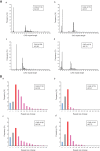Somatic expansion of the Huntington's disease CAG repeat in the brain is associated with an earlier age of disease onset
- PMID: 19465745
- PMCID: PMC2714728
- DOI: 10.1093/hmg/ddp242
Somatic expansion of the Huntington's disease CAG repeat in the brain is associated with an earlier age of disease onset
Abstract
The age of onset of Huntington's disease (HD) is determined primarily by the length of the HD CAG repeat mutation, but is also influenced by other modifying factors. Delineating these modifiers is a critical step towards developing validated therapeutic targets in HD patients. The HD CAG repeat is somatically unstable, undergoing progressive length increases over time, particularly in brain regions that are the targets of neurodegeneration. Here, we have explored the hypothesis that somatic instability of the HD CAG repeat is itself a modifier of disease. Using small-pool PCR, we quantified somatic instability in the cortex region of the brain from a cohort of HD individuals exhibiting phenotypic extremes of young and old disease onset as predicted by the length of their constitutive HD CAG repeat lengths. After accounting for constitutive repeat length, somatic instability was found to be a significant predictor of onset age, with larger repeat length gains associated with earlier disease onset. These data are consistent with the hypothesis that somatic HD CAG repeat length expansions in target tissues contribute to the HD pathogenic process, and support pursuing factors that modify somatic instability as viable therapeutic targets.
Figures


References
-
- Huntington's disease collaborative research group. A novel gene containing a trinucleotide repeat that is expanded and unstable on Huntington's disease chromosomes. Cell. 1993;72:971–983. - PubMed
-
- Vonsattel J.P., Myers R.H., Stevens T.J., Ferrante R.J., Bird E.D., Richardson E.P. Neuropathological classification of Huntington's disease. J. Neuropathol. Exp. Neurol. 1985;44:559–577. - PubMed
-
- Duyao M., Ambrose C., Myers R., Novelletto A., Persichetti F., Frontali M., Folstein S., Ross C., Franz M., Abbott M., et al. Trinucleotide repeat length instability and age of onset in Huntington's disease. Nat. Genet. 1993;4:387–392. - PubMed
-
- Andrew S.E., Goldberg Y.P., Kremer B., Telenius H., Theilmann J., Adam S., Starr E., Squitieri F., Lin B., Kalchman M.A., et al. The relationship between trinucleotide (CAG) repeat length and clinical features of Huntington's disease. Nat. Genet. 1993;4:398–403. - PubMed
Publication types
MeSH terms
Grants and funding
LinkOut - more resources
Full Text Sources
Medical

